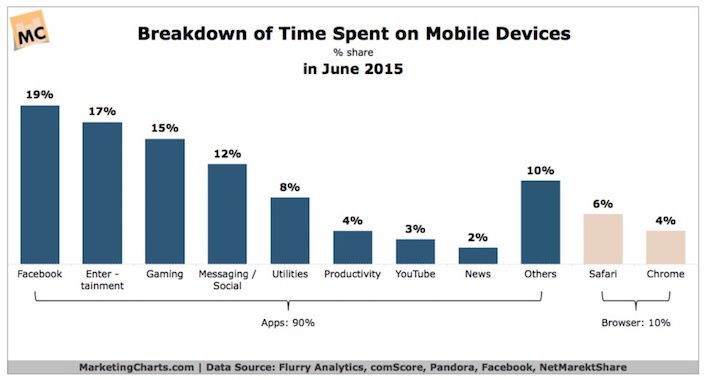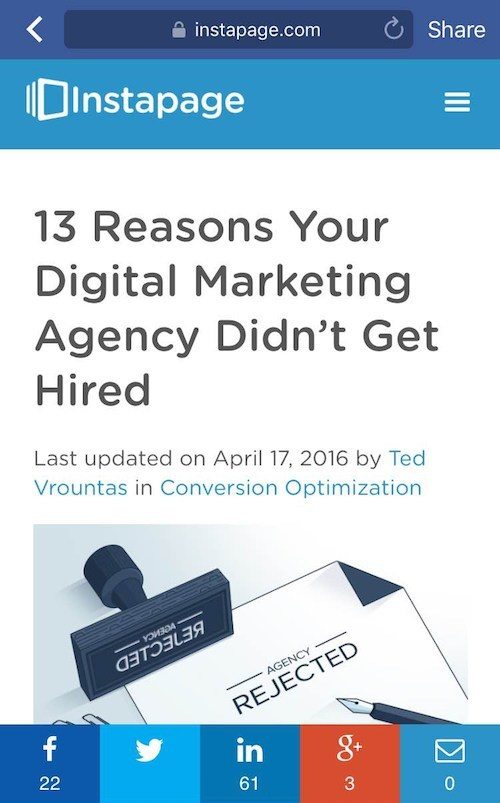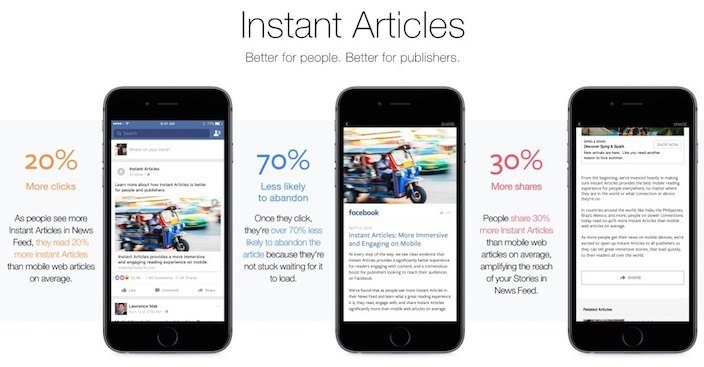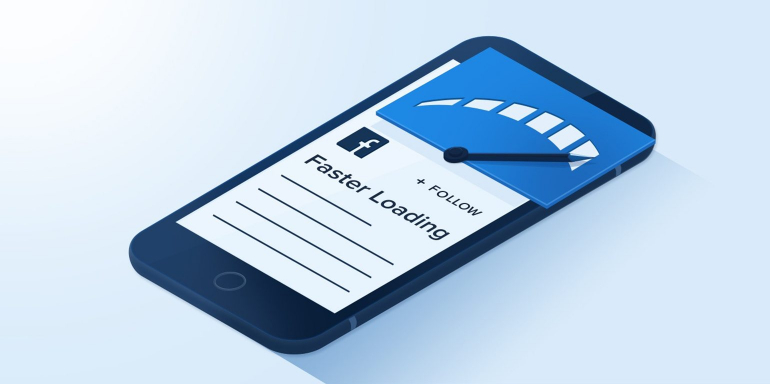As many marketers have discovered through trial and error, patience is not something much of the general public has anymore.
Today, according to Kissmetrics, 47% of all people expect a web page to load in two seconds or less. And if your page hasn’t loaded by three seconds, 40% of people will abandon it.
When you combine these stats with the fact that mobile websites, along with internet speeds worldwide, haven’t caught up with our ever shrinking attention span, it’s becoming vital that you figure out new ways to deliver content quickly, or risk being replaced by someone who can.
But in order to do that, you first need to understand how people today browse the web.
Modern-day internet browsing
Back in 2014, we saw the number of people accessing the internet via mobile surpass the number who do so via desktop.
Marketers lost it.
They scrambled to make their websites mobile-friendly to not only satisfy their visitors but survive the dreaded “mobilegeddon” that Google promised would come. And while it was a good move at the time, two years later, data is showing that they should maybe start directing their attention elsewhere — specifically to mobile apps.
Research has shown that on mobile we spend up to 90% of our time in apps:

The most used one? Facebook.
Knowing their popularity, the team at the social network has done everything in their power to keep people within their app with offerings like Canvas ads, mobile lead ads, and their newest program, Facebook Instant Articles.
What are Facebook Instant Articles?
Remember our blog post that covered Google’s “Accelerated Mobile Pages”? Well, Instant Articles are like Facebook’s version of those.
Having trouble connecting the dots? Allow us to explain…
When you click on a link post from Facebook, usually you’re redirected to the content publisher’s site. For example, if you click this post from your mobile device:

… you’ll be directed to this blog post on our mobile site:

Now, in theory, there’s nothing wrong with this process. But, as we all know, theories are often disproven.
In this case, when a user clicks on a Facebook post via mobile, they’ll theoretically reach the content instantly, as long as the publisher has done their mobile site optimization homework. But in a blog post from the company, product manager Michael Reckhow explains that’s not happening:
“People share a lot of articles on Facebook, particularly on our mobile app. To date, however, these stories take an average of eight seconds to load, by far the slowest single content type on Facebook.”
Eight seconds, coincidentally, is exactly the length of time our attention span has shortened to in 2016. Realizing this, along with our tendency to abandon a page if it doesn’t load instantly, Facebook created its “Instant Articles” program to appease our impatient minds. According to Josh Roberts, Product Manager:
“We built Instant Articles to solve a specific problem—slow loading times on the mobile web created a problematic experience for people reading news on their phones. This is a problem that impacts publishers of all sizes, especially those with audiences where low connectivity is an issue…Facebook’s goal is to connect people to the stories, posts, videos or photos that matter most to them. Opening up Instant Articles will allow any publisher to tell great stories, that load quickly, to people all over the world.”
To accomplish its goal, Facebook now allows publishers to host content on its servers, resulting in, literally, instant load times for content (hence the name “Instant Articles”). Here’s a video that shows the difference between the old format and the new:
.embed-container { position: relative; padding-bottom: 56.25%; height: 0; overflow: hidden; max-width: 100%; } .embed-container iframe, .embed-container object, .embed-container embed { position: absolute; top: 0; left: 0; width: 100%; height: 100%; }
But Instant Articles boast more than just speedy load times. They also allow for more interactivity for viewers with features that will remind you of Facebook’s new Canvas ad format:
- Tap media to expand it to a full-screen view
- Tilt and turn your mobile device to see peripherals of the image not immediately in view
- Watch autoplay video

The pros and cons of Facebook Instant Articles
We know that Instant Articles are good for Facebook — they keep people in their mobile app. We know they’re good for Facebook users, who get their content immediately. But what about you, the publisher?
The truth is, it’s a mixed bag.
Despite Instant Articles’ potential to delight fans of your content by delivering it more quickly, there are a few drawbacks to incorporating them into your marketing strategy:
- Publishers have expressed difficulty fitting Instant Articles into their business model, despite Facebook’s different monetization plans.
- If you use Facebook’s audience network to earn revenue via ads, the social network takes a 30% cut.
- If you sell your own ads, you keep 100% of the profit, but Facebook limits how many you can place within an article.
And the most glaring one of all is that people are no longer being directed to your mobile site.
As we all know, this is your hub of customer acquisition. It’s where your fans make their way down your marketing funnel by reading and sharing your content, (don’t forget that inbound links are still Google’s number one indicator of authority), signing up for your newsletter, or downloading a relevant ebook. But when their experience with your brand is limited within the context of Facebook, there are far fewer ways to engage them, and guide them through your funnel.
Knowing this, the social network has added features to make sure your fans’ experiences are tailored to your brand. They:
- Offer custom display themes for your Instant Articles that reflect your brand identity.
- Allow you to embed an email lead capture field at the bottom of your articles.
- Now let publishers post “branded content.”
- Include related content at the bottom of your articles that will direct your readers to more of your content.
So what’s the verdict? Do the pros outweigh the cons here? Let’s have a look…
The results… so far
While the Instant Articles program was just released to publishers of all sizes, Facebook has been working with a number of major brands over the last several months to test its effectiveness. So far, the social network has reported seeing marked improvements to a number of key performance metrics:

Those numbers are even higher in In countries like India, Brazil, Mexico, and the Philippines, where Facebook has found people read 20-40% more Instant Articles than mobile web articles.
Several brands have also reinforced Facebook’s early reports:
- Jeremy Gilbert of the Washington Post said: “Comparing our performance before and after we started using Facebook Instant Articles, we have seen a dramatic uplift in the number of people who come more than once a week to our content, so publishing on Facebook Instant Articles brings recirculation and a deeper engagement.”
- “We have to give people what they want, which is a fast, clean, reading experience — which seems to lead people into the content more,” explained Vice Chairman of Slate Magazine, Dan Check. He also shared that Slate’s Facebook visits have increased by 25% since its adoption of Instant Articles.
- Gawker CEO Nick Denton told press that Gawker’s unique visits had risen by 15%, along with overall visits by 31%, and pageviews by 48%.
- The Atlantic integrates about 85% of its content with Facebook Instant Articles. The team there believes that the more people they can reach, the more people they can convert into frequent readers, and eventually, paid subscribers. While the publisher’s audience has enjoyed the streamlined reading experience, they’re concerned that Facebook’s ban of native advertisements in the format will cost them a chunk of revenue that they were generating via their mobile site.
- News source, Mic, publishes all of their articles on Facebook Instant. While declining to give specific results, Chief Strategy Officer Cory Haik did say, “we wouldn’t be 100% if we didn’t feel good about it.”
Unfortunately, the evidence of Facebook Instant Articles’ success is all anecdotal at this point, with it being such a new offering. Until brands are willing to open up about their experience with the initiative, we’ll have to rely on what little information we’re hearing from Facebook and the first wave of big-name Instant publishers.
If that’s not good enough for you, as of April 12th, you can start testing them yourself.
How to begin using Facebook Instant Articles
Step 1: Sign up
The first step in getting started is to head here and sign up for Facebook Instant articles.
Step 2: Choose the Facebook page you want to publish with
Once you sign up, Facebook will ask you to choose which page you want to publish your Instant Articles to. Select it, and then…
Step 3: Claim your URL
This URL is going to serve as the basis of all your Instant Articles. It’s where on your website you publish content that you’ll eventually want to convert (for most it’s the blog).
Keep in mind, claiming this URL doesn’t mean that from here on out all the content you post within it will be published as an Instant Article. You’ll have to manually convert each one. To learn more about claiming URL’s click here.
Step 4: Submit articles
After your first batch of submitted articles has been approved by the team at Facebook, you’ll be able to begin publishing them to the social network.
To make converting to Instant easy, Facebook developed an all-in-one way for publishers to integrate their content with the new system. You can do it all from your CMS. You’ll have the option to:
- Publish your articles from WordPress using this plugin
- Publish via other platforms like Drupal, Tempest, Medium
- Publish using an RSS feed if you don’t use a CMS supported by Facebook
- Publish content directly from your CMS using an API
Deliver Facebook content faster than ever before
As an initiative less than a year old, the long-term effectiveness of Facebook’s Instant Articles remains to be seen.
If you’ve already leveraged them to deliver content to your fans more quickly than ever before, share your experience with us in the comments!
If you’re still on the fence about whether or not to sign up because you’re afraid of giving up control to Facebook, remember that the social network doesn’t have to be the final destination for your fans. Instant articles can serve as a step in your conversion funnel the same way any other Facebook content would.
Once you’ve guided them through every step of your funnel, publish a post-click landing page to Facebook in a few easy steps using Instapage’s software to convert your fans into customers.
